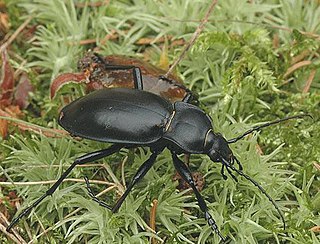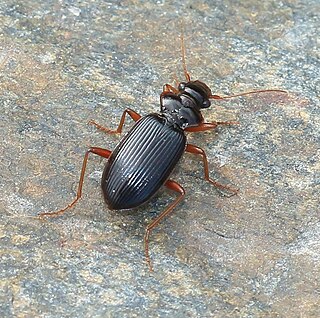
Beijing Film Academy is a municipal public college in Beijing, China. It is affiliated with the City of Beijing, and co-funded by the Beijing Municipal People's Government, the National Radio and Television Administration, and the Ministry of Education.

Shek Wing-cheung, better known by his stage name Shih Kien, Sek Kin, Sek Gin or Shek Kin, was a Hong Kong actor and martial artist. Shih is best known for playing antagonists and villains in several early Hong Kong wuxia and martial arts films that dated back to the black-and-white period, and is most familiar to Western audiences for his portrayal of the primary villain, Han, in the 1973 martial arts film Enter the Dragon, which starred Bruce Lee.

Carabus is a genus of beetles in the family Carabidae. The genus is highly diverse with 94 subgenera, 959 species and 2300 subspecies, thus is the largest genus in the subfamily Carabinae. The vast majority are native to the Palearctic, but 16 Nearctic species are also known. Carabus spp. are 12–50 mm (0.47–1.97 in) long, and most species are wingless and often very colourful. These are nocturnal, predatory beetles that feed on snails, earthworms, and caterpillars. Most Carabus species were thought to have inhabited the Eurasian forest, but the species' low dispersal abilities altered the distribution of lineages within the genus.

Esther Huang, formerly known as Albee Huang, is a Taiwanese actress and singer. She is a former member of the Taiwanese girl band Hey Girl. She is sometimes known as Xiao Xun in the media along with other pseudonyms.

Cychrus is a large genus of rare snail-eating beetles in the family Carabidae. There are at least 160 described species in Cychrus. They are found throughout the world, although more than 80% of the species occur in China.

Leistus is a genus of ground beetles in the family Carabidae. There are more than 250 described species in Leistus, found in the Holarctic.
Qianotrechus is a genus in the ground beetle family Carabidae. There are about five described species in Qianotrechus, found in China.
Sinaphaenops is a genus in the beetle family Carabidae. There are about 13 described species in Sinaphaenops, found in China.
Sinotroglodytes is a genus in the beetle family Carabidae. There are about five described species in Sinotroglodytes, found in China.
Orthogonius kubani is a species of ground beetle in the subfamily Orthogoniinae. It was described by Ming-Yi Tian and Thierry Deuve in 2006.
Orthogonius lancangjiang is a species of ground beetle in the subfamily Orthogoniinae. It was described by Tian & Deuve in 2006. This species resides mainly in Southeast Asia in Vietnam and Laos.
Orthogonius ovatulus is a species of ground beetle in the subfamily Orthogoniinae. It was described by Ming-Yi Tian and Thierry Deuve in 2003.
Kwan Shan was a Hong Kong film actor. Kwan appeared as a romantic lead actor in Mandarin-language films created in Hong Kong, especially during the 1960s. His roles included several Shaw Brothers Studio productions.

Inborn Pair is a 2011 to 2012 Taiwanese romantic comedy drama television series created and developed by SETTV. It stars Annie Chen and Chris Wang as the main leads, and directed by Golden Bell Award winning director Feng Kai (馮凱). Filming began on November 18, 2011 and debuted on SETTV ETTV on December 13, 2011. Its final episode aired on April 9, 2012 with 84 episodes in total.

Mr. Right Wanted is a 2014 Taiwanese comedy, romance television series produced by UDN Productions, starring Sonia Sui, Christopher Lee, Kuo Shu-yao, Jerry Huang, Hans Chung, Chang Shao Huai, and Emerson Tsai. Filming began on December 23, 2013 and finished on June 7, 2014. First original broadcast began November 7, 2014 on TTV channel, airing on Friday nights from 10:00-12:00 pm.
Rookies' Diary is a military comedy television series created in Taiwan. It has a total of 43 episodes of approximately 1 hour each. It aired from July 2, 2010 to April 22, 2011. The series is about how a group of teenagers whom are training in the military or army as recruits for 36 days. The director of the series is Wang Wei. It was also one of the most popular and well known dramas in Taiwan, because of it based on military and army just like the Singapore's military movies Ah Boys to Men and Ah Boys to Men 2 from the Ah Boys to Men film series, which was directed by popular and successful local film director Jack Neo.

Trechini is a large tribe of ground beetles in the family Carabidae. There are more than 270 genera and over 2,400 described species in Trechini, found throughout the world.
Anthony John Whitten was a British conservationist, zoologist, and herpetologist. He was a senior adviser at Fauna and Flora International, where he was regional director for Asia Pacific, and was a former biodiversity specialist with the World Bank. He co-authored several books on the ecology of Southeast Asia and published over 100 field guides in local languages. Born in Dulwich, London, Whitten attended Dulwich College and the University of Southampton. In graduate school he spent two years studying gibbons on the Indonesian island of Siberut, earning his PhD from Cambridge in 1980. He and his wife, zoologist Jane E. J. Whitten, later lived in Indonesia for 10 years. He established a working group on karst ecosystems for the International Union for Conservation of Nature (IUCN), and in 2016 was part of a research team that discovered 15 new species of geckos in Myanmar. He died in 2017, aged 64, as the result of a car collision while bicycling. He is commemorated in the scientific names of at least 13 species, including the geckos Hemiphyllodactylus tonywhitteni and Cnemaspis whittenorum.









